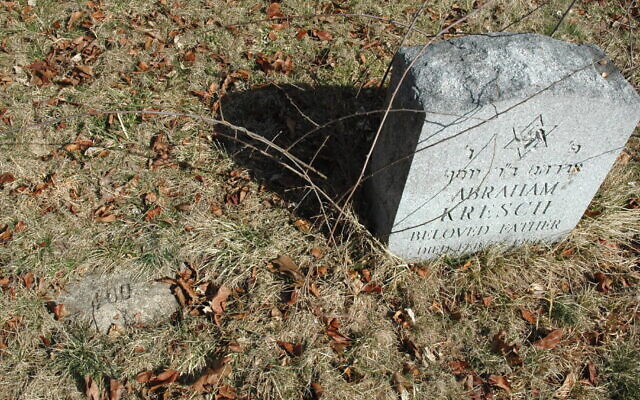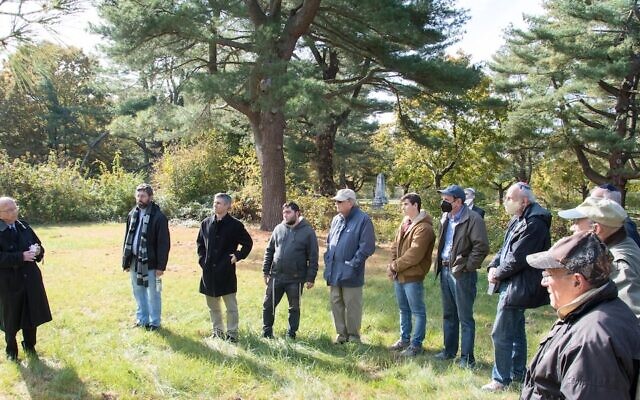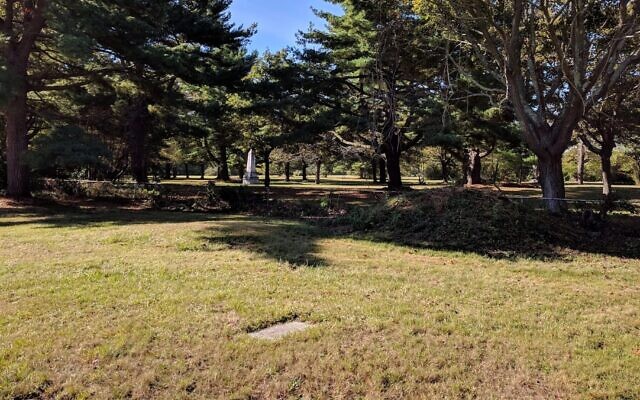New York Jewish Week via JTA – Brian Madigan of Locust Grove, Virginia, found something odd while researching his family tree: Although his maternal grandfather lived in Brooklyn, he was buried in East Islip on New York’s Long Island. ,
Further research revealed that his ancestor, Napoleon Heidemark, was committed to the Central Islip Psychiatric Center sometime before 1900. He died on November 21, 1916 at the age of 72. He was named with only a number in its cemetery. his grave.
Several weeks earlier, Madigan wrote to the New York State Office of Mental Health asking for a copy of his relative’s “complete file” to learn the circumstances under which he was committed, the exact location of his grave, and his photograph. a copy of.
“I’m just looking for some kind of closure,” said 63-year-old Madigan. “I plan to go there and I would like to know the location of his grave so that I can put up a marker [with Hedemark’s name], I cannot live without a mark on the graves of my ancestors.”
Madigan, a defense contractor, may be getting its finale — thanks to a twice-delayed agreement between a Jewishly affiliated law school and the Office of Mental Health. Before the COVID pandemic hit, they had agreed to look after the Jewish and non-Jewish parts of the cemetery and to assist relatives who believe a loved one is buried there.
For Napoleon Heidemark and other former patients to intercede at the cemetery, it is an opportunity to restore the dignity in death that may have been denied in the 120-year history of one of the largest psychiatric hospitals in the United States. Is. The rejected dead include Holocaust survivors, who were given numbers twice instead of names.
Madigan was sent to the state by Sam Levin, director of the Jewish Law Institute at the Touro Law Center, which was built on a portion of psychiatric hospital property after it closed in 1998. The cemetery is all that remains of the hospital, which was opened in 1889. The cemetery contains the graves of an estimated 5,500 former patients from not only the Central Islip Facility, but also King’s Park and Pilgrim State Psychiatric Hospitals. After Central Islip Hospital closed, the state closed the cemetery, restricted public access, and provided mowing and cleaning.
Shortly after the Touro opened in 2007 A law school “in line with Jewish tradition,” Ken Rosenblum, then the school’s associate dean of admissions, walked out the school’s south door and saw a rusty fence at the end of the parking lot.
Pushing aside the overgrown brush, he began to walk across an empty field, until he realized that he was stepping on tombstones and rectangular stones, which are flush with the earth, containing numbers. Then he saw two iron gates covered with vines, each marked with the rusty star of David.
While Rosenblum was unaware that there was a Jewish cemetery with about 500 graves in the backyard of Touro, others remembered. The Jewish section was consecrated in 1980 by Rabbi Melvin Lerer, a former Jewish pastor at the psychiatric center. He raised funds for the restoration of the cemetery, the installation of the gate with the Star of David, and the purchase of proper headstones for all future interventions, which numbered about 100 by the time the hospital was closed.

On the left are traces of a Jewish grave at the former Central Islip Psychiatric Center on Long Island, New York. A stone was added to the right after the hospital began working with the Jewish Burial Society. (via Patricia Desrochers/Turo Law Center/JTA)
Ben Atkin, president of the Men’s Club at the North Shore Jewish Center in Port Jefferson, Long Island, said that every year for the past 30 years the Men’s Club has held a ceremony in the Jewish section of the cemetery in which he recited Morner. Kaddish for those buried there.
“We’ve never failed to have a minion. These guys have no one to say kadish to them.” “We go every year after the high holidays. We walk around and clean up some footrests that have been covered up. And we tell some tales. The people buried there deserve it. It’s a shame that they were buried under just one number.
Until a few years ago, Lerer would attend this annual ritual and often remark that those buried there were forgotten in life and abandoned in death, Levine said.

Members of the Men’s Club at the North Shore Jewish Center in Port Jefferson, New York, hold a ceremony in the Jewish section of the Central Islip Psychiatric Center’s cemetery on November 11, 2021. (via Ray Sela/JTA)
In an interview, 92-year-old Lerer suggested how many people would come to the hospital cemetery for burial, without naming people to remind them of who they were. “Most of them were dispossessed families,” said Lerer, who retired in 2018 after 42 years as a Jewish pastor in the pilgrimage state and in Central Islip before that. “Many people were in the hospital for 40, 50 or 60 years, and they were the only survivors in their family.”
Some families were “embarrassed that they had a relative in a psychiatric hospital and therefore did not want to claim the body. So I arranged for the funeral and Chevra Kadisha [burial society] of Shomarei Hadas Chapel in Borough Park. At every funeral, there was only me, the person who died and the gravedigger. ,
Hired in 1976 in Central Islip, Lerer met with the hospital’s deputy director and soon had an area designated as a Jewish cemetery.
Since then, every person buried in the Jewish cemetery has had a headstone bearing a Jewish star, their name in English, the date in both Hebrew and English, and the words in Hebrew: “May their souls be bound in bondage to eternal life. “

The Jewish cemetery at the former Central Islip Psychiatric Center on Long Island consists of small stones, many of which are engraved only with numbers, marking the graves of many of the 500 Jewish patients buried there. (via Patricia Desrochers/Turo Law Center/JTA)
In October 2013, the law school and the state signed their agreement in which the Office of Mental Health agreed to restore the cemetery and help relatives identify ancestors who lay under the numbered stones. The project was delayed for several years before being revived in 2019.
“There were plans to hold a big event at which we would set up a historical marker in the cemetery, but then COVID came along and that was no longer a priority,” Levine said.
James Plastiras, a spokesman for the Office of Mental Health, said the project is once again underway, and will include adding a historic marker and existing walkways.
He added that families through the Records Department of Supervising Facilities are free to place approved markers on relatives’ graves “once direct lineage is established”.
Rosenblum, who is now retired, also noted that some of those interred at the cemetery were Holocaust survivors.
“I felt great to be involved in the cemetery when I learned that Holocaust survivors were buried there,” Rosenblum said. “It was one of the reasons I made myself a pest to get funding for a beautiful new fence. … We wanted to pave the central walkway and put up benches so that the students could use it as a place of quiet reflection. and there will be limited public access.”